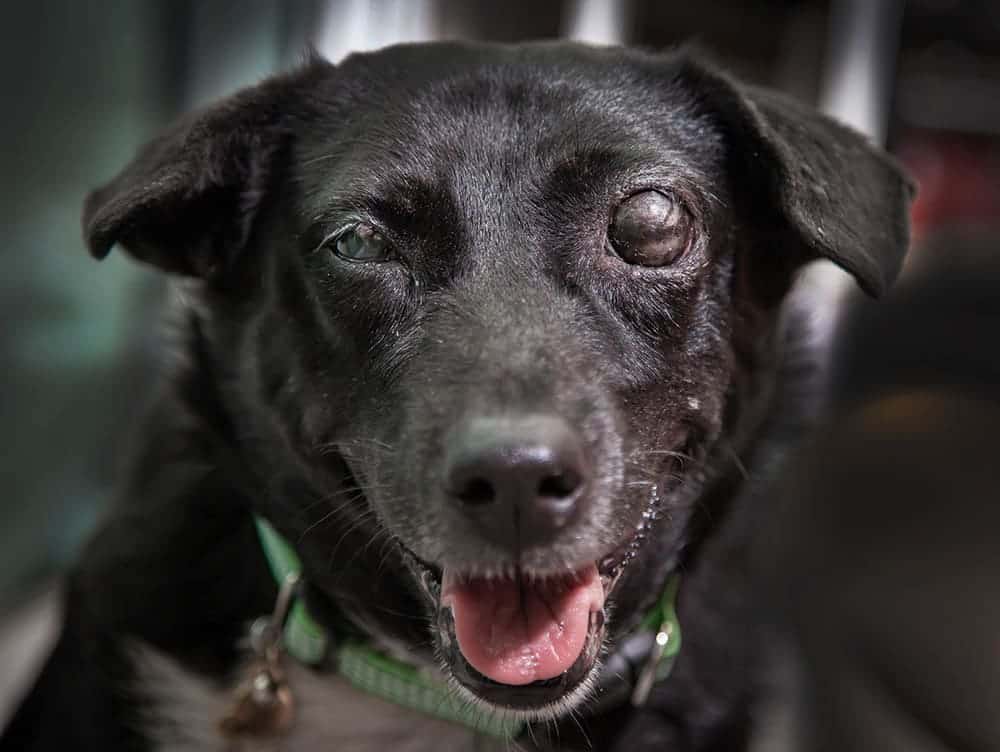An old phrase says, “The eyes are the windows to the soul.” But what if those eyes are cloudy and look like there’s a storm a brewin’?
There are a few reasons why your dog has cloudy eyes, so keep reading if this is your dog. We’re discussing five possibilities for cloudy eyes in dogs and whether or not they can be treated.
The 5 Reasons My Dog’s Eyes Are Cloudy
1. Cataracts
Cataracts are faint cloudiness in your dog’s eyes that grows over time. They block out light and reduce vision, sometimes resulting in blindness.
Dogs develop cataracts for a few reasons like diabetes, a nutritional deficiency, trauma, or inherited disease. Other times, it just means your dog is aging.
Certain breeds of dogs have a higher chance of developing cataracts in their eyes, such as the:
- Australian Shepherd
- Boston Terrier
- Havanese
- Silky Terrier
- French Bulldog
- Bichon Frise
- American Staffordshire Terrier
- Mini Schnauzer
- Poodle
- West Highland Terrier
- Cocker Spaniel
- Siberian Husky
- Labrador Retriever
Can It Be Treated?
Generally, if the cataract covers 30% or less of the eye, your dog’s vision is fine. But eventually, cataracts will flaw your dog’s vision.
Thankfully, cataracts can be removed from surgery and dogs get back to their everyday business after just a few days.
2. Glaucoma
Glaucoma is when the eye can’t drain fluid properly and builds pressure inside the eye. The outcome is your dog’s eye looking like a storm cloud.
Dogs can have inherited glaucoma or secondary glaucoma. Secondary glaucoma results from another medical condition, like cataracts or cancer.
As the name suggests, inherited glaucoma is when your dog acquires the problem from genetics. A few dog breeds are usually more prone to glaucoma than other breeds. These include:
- Beagle
- Boston Terrier
- Great Dane
- Akita
- Chow Chow
- Alaskan Malamute
- Dalmatian
- Greyhound
- Cocker Spaniel
- Welsh Springer Spaniel
- English Cocker Spaniel
- Smooth-Haired Fox Terrier
- Giant Schnauzer
- Mini Schnauzer
- Shih Tzu
- Shar Pei
- Basset Hound
- Siberian Husky
- Norwegian Elkhound
- Russell Terrier
- Poodle
Can It Be Treated?
Glaucoma is very painful for your dog and can cause permanent damage, so you want to seek veterinary help as soon as possible. Aside from cloudiness, other signs of glaucoma include:
- Watery discharge
- Lethargy
- Eye swelling or bulging
- Unresponsiveness
- Inappetance
- Lethargy
Your veterinarian will reduce the eye pressure as quickly as possible to avoid permanent eye damage. Once the pressure is stable, your veterinarian will offer pain medicine and other medications to promote eye drainage and fluid production.
In some severe cases, surgery may be necessary.

3. Nuclear Sclerosis
Nuclear sclerosis is a simple change in the eye lens. It is similar to cataracts except it doesn’t cause as much vision impairment.
Many dog owners confuse nuclear sclerosis with cataracts. The biggest difference to look for is the eye color. Nuclear sclerosis causes a bluish coloration. With cataracts, your dog’s eye will have a whitish opacity.
Can It Be Treated?
Luckily, nuclear sclerosis doesn’t cause any pain or much vision impairment, so there’s really nothing to treat. However, it’s a sign your dog is aging, so it’s good to talk to your vet about your dog’s health.
4. Ulcers
Ulcers are sores on your dog’s cornea. The cornea is a membrane located at the front of the eye that bends light to help the eye focus.
The cornea has three layers: epithelium, stroma, and Descemet’s membrane. Unfortunately, these layers can deteriorate over time. An eye ulcer is a deep deterioration that penetrates the stroma level. The result is a cloudy appearance in your dog’s eye, but you may notice a reddish or bluish tint as well.
Can It Be Treated?
Eye ulcers are very painful and should be treated as an emergency. Typically, your dog will rub at its eye constantly and seldom opens the eyelid. You may even notice watery discharge.
The type of treatment depends on the level of membrane damage, so your vet will need to perform certain tests first.
5. Anterior Uveitis
The uvea is a frontal part of the eye made up of the iris, ciliary body, and choroid. This area gives the eye color and provides fluid for the eye. Anterior uveitis is the inflammation of the ciliary body and the iris simultaneously.
Can It Be Treated?
The symptoms are like glaucoma, except eye pressure remains low. So, make sure you take your dog to the vet promptly if you suspect any eye issues.
Aside from cloudiness, your dog might experience pain and eye redness. You may notice blood in the eye and excessive watering. Your vet will address the reason for the issue developing and offer pain medication and reduce inflammation with topical eye creams.
Conclusion
It’s hard to admit that our dogs age faster than we do. Seeing cloudiness in your dog’s eye reminds us of that fact. But sometimes, cloudiness stems from other medical concerns. Whatever the case, it’s important to schedule an appointment with your vet as soon as possible to find the cause of the issue.
Featured Image Credit: Susan Edmondson, Shutterstock














